You can transform your apartment balcony into a green oasis, even as a newbie. Begin with small, manageable projects like a 12-inch pot for herbs; basil and mint grow well in tight spaces with 6 hours of sunlight. Use well-draining soil— a mix of potting soil and perlite—to avoid root rot, a condition where roots decay from excess water. Curious about more ideas? Stick around for practical tips!
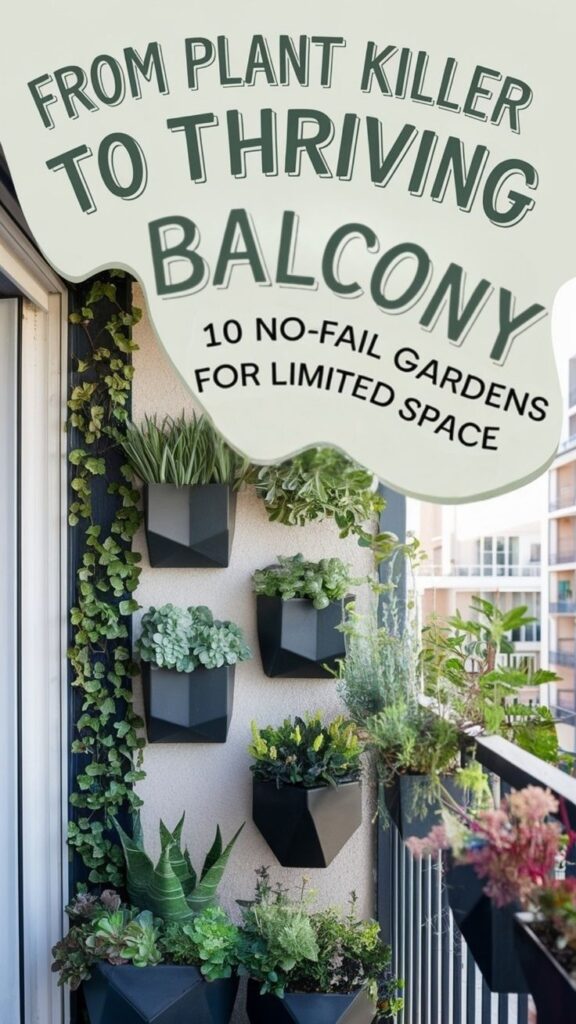
Contents
- 1 Herb Haven on a Small Ledge
- 2 Succulent Sanctuary for Easy Care
- 3 Vertical Veggie Patch for Tight Spaces
- 4 Potted Flower Corner for Colorful Vibes
- 5 Miniature Fruit Tree Nook
- 6 Hanging Basket Greenery Setup
- 7 Compact Cactus Collection
- 8 Balcony Rail Planter Ideas
- 9 Tiny Tropical Escape
- 10 Mixed Greens Micro Garden
Herb Haven on a Small Ledge
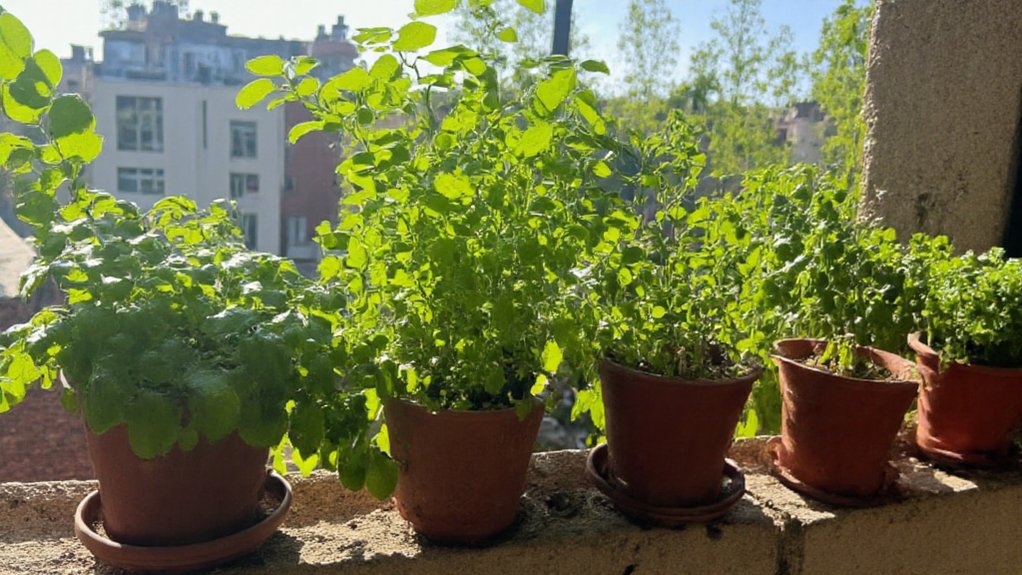
Creating a herb haven on a small ledge is a perfect way for apartment dwellers to start their balcony garden journey. Even with limited space, a narrow ledge can be transformed into a thriving spot for growing fresh herbs like basil, mint, thyme, and parsley. These plants are ideal for small spaces because they don’t require much room to grow and can thrive in pots or containers that fit snugly on a ledge.
To set up your herb haven, choose containers with good drainage, place them securely on the ledge, and make sure they get at least 4-6 hours of sunlight daily. Herbs are low-maintenance, needing only regular watering and occasional trimming to encourage growth. This mini garden not only adds greenery to your balcony but also provides fresh, homegrown flavors for your cooking.
Succulent Sanctuary for Easy Care

Creating a succulent sanctuary on your apartment balcony is a fantastic choice for beginners due to the low-maintenance nature of these plants. Succulents, such as aloe vera, echeveria, and sedum, thrive in well-draining soil and require minimal watering, making them ideal for small spaces and busy lifestyles. Their ability to store water in their leaves means they can withstand periods of neglect, perfect for those new to gardening or with limited time.
To set up your succulent sanctuary, choose a sunny spot on your balcony since most succulents need at least 4-6 hours of direct sunlight daily. Use shallow containers or pots with drainage holes, filled with a cactus or succulent-specific potting mix to prevent root rot. Arrange a variety of succulents for visual interest, mixing different shapes, sizes, and colors, and consider adding small rocks or pebbles as a decorative touch. With just occasional watering—typically once every 1-2 weeks depending on the climate—you’ll have a vibrant, drought-tolerant garden that adds charm to your outdoor space.
Vertical Veggie Patch for Tight Spaces

Creating a vertical veggie patch is an ideal solution for apartment dwellers with limited balcony space. By utilizing vertical structures like wall-mounted planters, trellises, or tiered shelving units, you can grow a variety of vegetables and herbs without taking up valuable floor space. This method not only maximizes your growing area but also adds a visually appealing green element to your balcony.
To start, choose lightweight containers or pockets that can be easily mounted on walls or hung from railings. Opt for vegetables and herbs that thrive in confined spaces, such as cherry tomatoes, lettuce, spinach, and basil, and make sure they receive adequate sunlight and water. With a little creativity, a vertical veggie patch can transform even the smallest balcony into a productive mini-garden.
Potted Flower Corner for Colorful Vibes

Creating a potted flower corner on your apartment balcony is a fantastic way to infuse vibrant colors and lively vibes into your outdoor space. Start by selecting a variety of flowering plants that thrive in containers, such as petunias, marigolds, or geraniums, which offer bright blooms and are relatively easy to care for. Arrange these pots in a dedicated corner of your balcony, using different heights with plant stands or stacking crates to create visual interest and maximize space.
Consider the sunlight and wind conditions of your balcony when choosing flowers, as some may need more shade or protection. Regularly water and deadhead spent blooms to encourage continuous flowering, and add a small decorative element like a colorful mat or fairy lights to enhance the cozy, inviting atmosphere of your flower corner.
Miniature Fruit Tree Nook
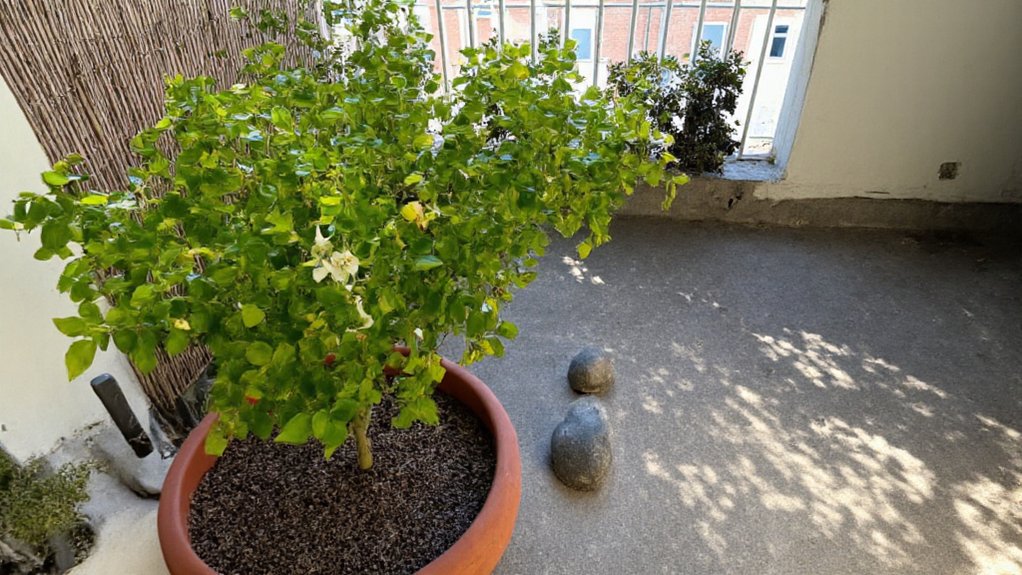
Creating a miniature fruit tree nook on your apartment balcony is a delightful way to bring a touch of orchard charm to a small space. Dwarf or patio fruit trees, such as apple, lemon, or fig varieties, are perfect for container gardening due to their compact size and ability to thrive in pots. Choose a sunny corner of your balcony that receives at least 6-8 hours of direct sunlight daily, as most fruit trees require ample light to produce fruit. Place the tree in a large, well-draining container with a saucer to catch excess water, and make sure the pot is elevated slightly to prevent root rot.
When setting up your nook, consider adding a small trellis or support for climbing varieties or to help stabilize the tree against wind. Surround the base with mulch to retain moisture and add a few decorative elements like pebbles or small garden ornaments to enhance the aesthetic. Regular watering, proper fertilization, and seasonal pruning will keep your miniature fruit tree healthy and productive, allowing you to enjoy fresh, homegrown fruit right from your balcony.
Hanging Basket Greenery Setup
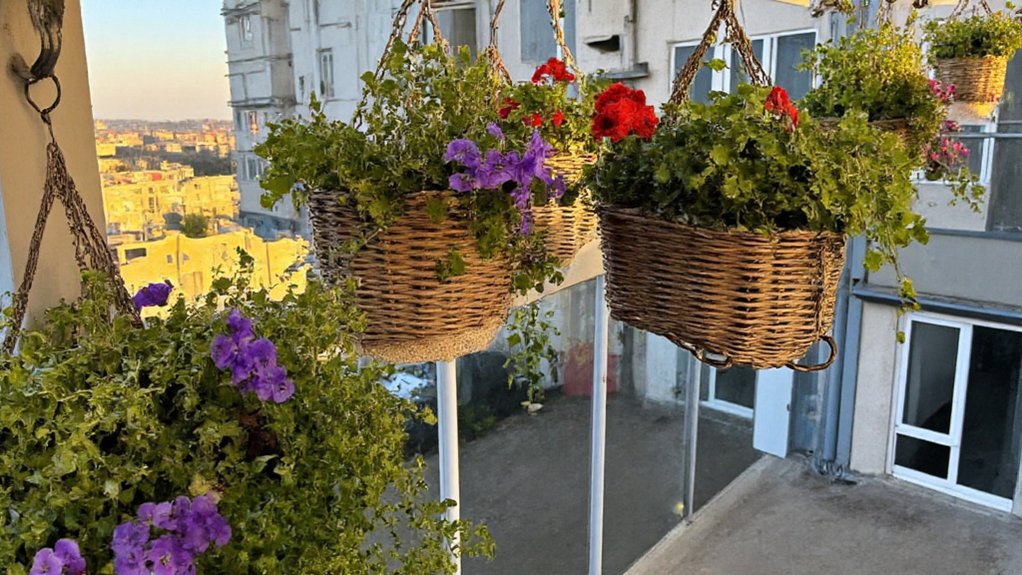
Hanging basket greenery is a fantastic way to maximize space on an apartment balcony while adding a lush, vertical element to your garden. These baskets can be suspended from railings, hooks, or overhead structures, allowing you to grow a variety of plants like trailing flowers, herbs, or even small vegetables without taking up floor space. Choose baskets with good drainage and line them with moss or a coconut fiber liner to retain moisture while preventing soil from spilling out.
To set up, select a sturdy hanging mechanism that can support the weight of the basket, soil, and plants, especially after watering. Opt for lightweight potting mix specifically designed for containers to reduce the load. Position your baskets in areas that match the light and water needs of your chosen plants—some may thrive in full sun, while others prefer partial shade. Regular watering is key, as hanging baskets tend to dry out faster due to exposure to wind and sun, so check them daily and consider a drip irrigation system for convenience.
Compact Cactus Collection
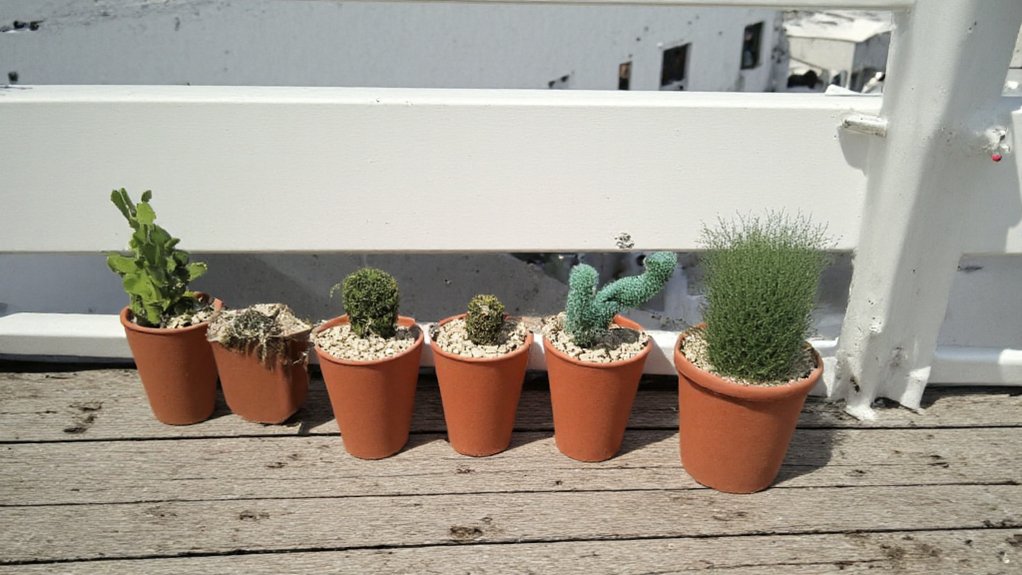
A Compact Cactus Collection is an ideal choice for newbie gardeners looking to add low-maintenance greenery to their apartment balcony. Cacti are hardy, drought-tolerant plants that thrive in small spaces and require minimal care, making them perfect for beginners or those with limited time. With a variety of shapes, sizes, and textures, a small collection of cacti can create a visually striking display in pots or containers, adding a touch of desert charm to your outdoor space.
To start, select a few different types of cacti, such as the classic prickly pear, barrel cactus, or the petite pincushion cactus, and arrange them in well-draining soil within shallow containers. Place them in a sunny spot on your balcony, as most cacti need plenty of direct sunlight to grow. Water sparingly—only when the soil is completely dry—since overwatering is a common mistake that can harm these resilient plants. With just a little attention, your compact cactus collection will flourish with minimal effort.
Balcony Rail Planter Ideas
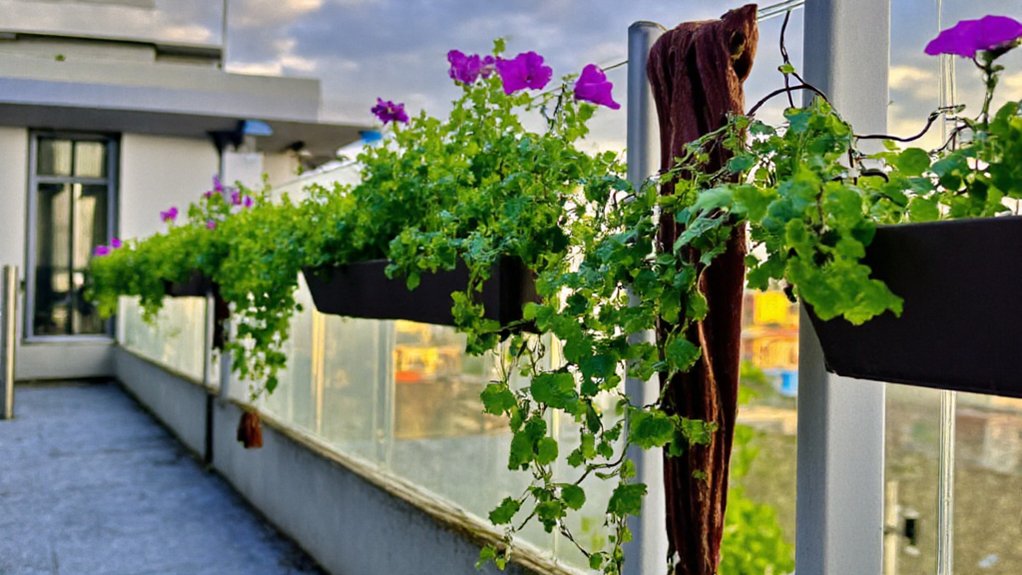
Balcony rail planters are a fantastic way to maximize space and add greenery to your apartment balcony. These planters are designed to hang securely over the railing, allowing you to grow a variety of plants without taking up valuable floor space. They come in various materials like metal, plastic, or wood, and can be customized to match your balcony’s aesthetic. Whether you opt for vibrant flowers, cascading vines, or even small herbs, rail planters can transform a plain railing into a lush, vertical garden.
When choosing rail planters, make sure they have proper drainage to prevent water buildup and root rot, and consider the weight capacity of your balcony railing to avoid overloading it. You can mix and match different plants for a dynamic look—think trailing ivy paired with colorful petunias or a mini herb garden with basil and thyme for easy access while cooking. Rail planters are not only practical but also add a charming, personalized touch to your outdoor space.
Tiny Tropical Escape
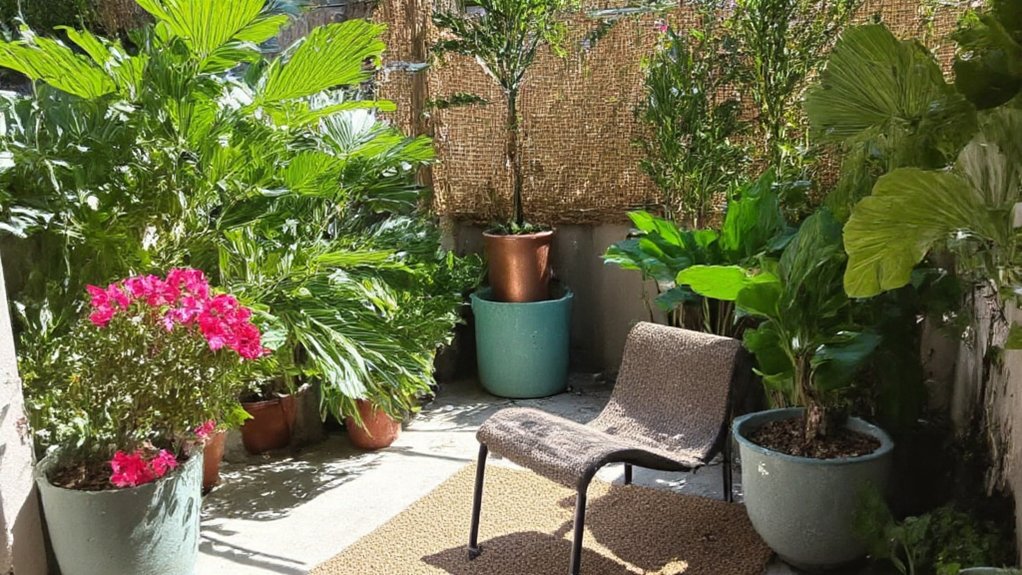
Creating a Tiny Tropical Escape on your apartment balcony can transform a small outdoor space into a lush, vibrant oasis. By incorporating tropical plants like ferns, palms, and hibiscus, you can mimic the feel of a faraway island getaway. Choose plants that thrive in your climate or opt for hardy varieties that can withstand varying temperatures, and use colorful pots or hanging baskets to add a playful, exotic vibe.
To enhance the tropical theme, add elements like bamboo screens for privacy, a small water feature for a calming effect, or even string lights to create a warm, inviting atmosphere at night. Arrange your plants in layers, with taller ones at the back and smaller ones in front, to maximize space and create depth. With just a few thoughtful touches, your balcony can become a mini paradise where you can unwind and escape the daily grind.
Mixed Greens Micro Garden
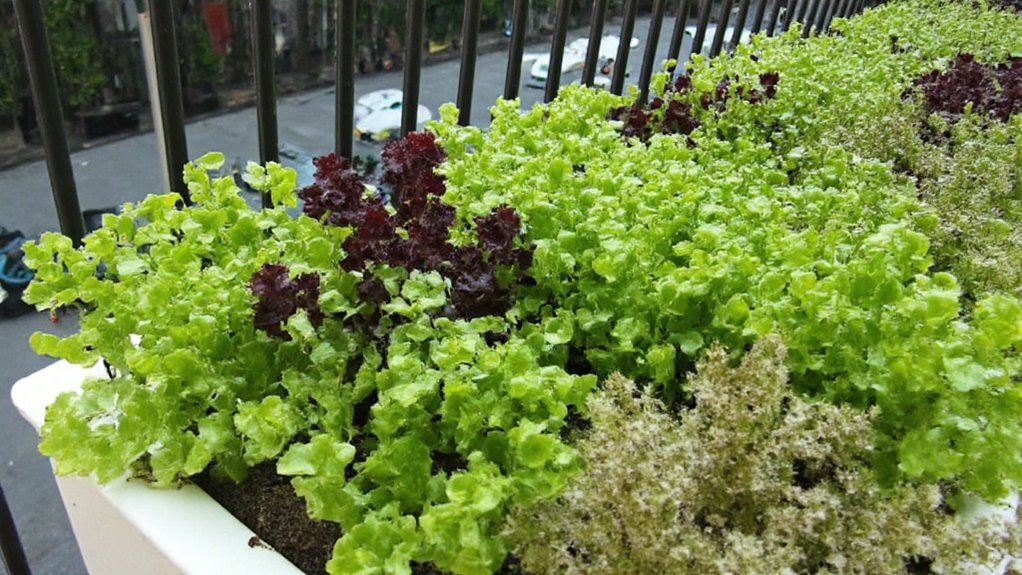
A Mixed Greens Micro Garden is an ideal way for apartment dwellers to grow a variety of fresh, nutritious greens right on their balcony. This type of garden focuses on cultivating small, fast-growing leafy vegetables like lettuce, spinach, arugula, and kale in compact containers or trays. It’s perfect for beginners because these greens require minimal space, grow quickly, and can thrive in partial sunlight, which is often the case on balconies with limited direct sun exposure.
To start, choose shallow containers with good drainage and fill them with a lightweight potting mix. Sow a mix of seeds for different greens to achieve a diverse harvest, and water them regularly to keep the soil moist but not waterlogged. Within a few weeks, you’ll have a steady supply of fresh greens for salads, smoothies, or garnishes, all grown in a small, manageable space that fits perfectly into balcony living.
